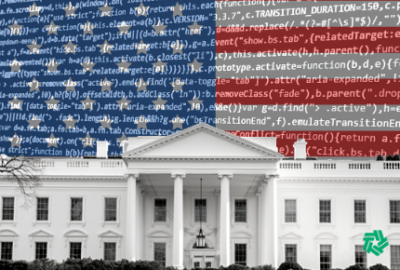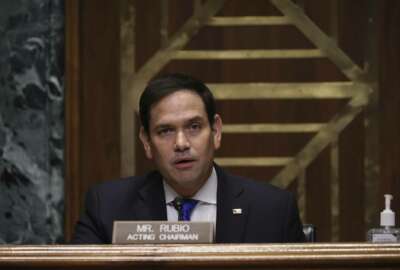
UPDATED
Congress secures more paid leave for federal employees in new COVID-19 relief law
The $1.9 trillion COVID-19 relief package gives federal employees access to a new bank of paid leave, which will allow them to recover from COVID-19 and care for...
This story was updated on Thursday, March 11, 2021 at 2:15 p.m. to reflect President Joe Biden has signed the COVID-19 relief bill into law.
Congress on Wednesday passed a sweeping $1.9 trillion COVID-19 relief package, known as the American Rescue Plan, which will provide federal employees with a few new benefits.
The Senate passed the COVID-19 relief package with some modifications on Saturday, sending it back to the House for another vote.
The House cleared the final version of the bill Wednesday afternoon with a 220-211 vote. No Republicans voted for the bill. President Joe Biden signed the bill into law Thursday afternoon.
The American Rescue Plan includes a few provisions that are notable for federal employees. At the top of the list is more paid leave for the vast majority of employees.
The COVID-19 relief package includes $570 million to pay for additional emergency paid leave, a program that sparked some debate among members of Congress in recent weeks.
Full-time federal employees will be able to receive up to 600 hours, or 15 weeks, of paid leave to recover from COVID-19, quarantine or care for a sick family member or a child who is attending virtual school due to the pandemic.
Employees could also use the leave for the purposes of receiving a COVID-19 vaccine or recovering from any symptoms or conditions related to immunization.
There are, however, a few exceptions. Employees can’t use this new emergency paid leave at the same time as any other kind of paid time off, and the leave benefits will be capped at $1,400 a week.
Notably, leave paid to employees will reduce their total service for the purposes of calculating their federal retirement benefits, according to the legislative text.
The vast majority of federal employees are eligible to use this new type of emergency leave, including workers at the Postal Service, Postal Regulatory Commission, the Public Defender Service for the District of Columbia and the D.C. courts.
Employees at the Department of Veterans Affairs, Transportation Security Administration and the Federal Aviation Administration are also eligible for the new bank of paid leave.
Federal employees will be able to tap into this new emergency paid leave bank through September 2021.
“There have been cases where federal employees who should be staying home, in quarantine, have insisted on coming into work because they don’t have enough personal leave and can’t afford leave without pay,” Tony Reardon, national president of the National Treasury Employees Union, said Wednesday. “This emergency leave benefit will help them and also protect their coworkers.”
Beyond additional paid leave, the COVID-19 relief package also includes a provision guaranteeing workers compensation benefits to certain federal employees who have contracted the virus and raise a claim with the Labor Department.
The legislation essentially presumes federal employees who have direct contact with patients or members of the public contracted COVID-19 on the job. That presumption means employees may have an easier time filing for workers compensation benefits with the Labor Department, because they won’t need to prove they contracted the virus at work.
“This change will allow employees or their survivors to receive workers’ compensation benefits under the Federal Employees Compensation Act without facing denials or lengthy appeals,” Everett Kelley, national president of the American Federation of Government Employees, said Wednesday in a statement.
AFGE has been pushing for an automatic presumption of illness for frontline employees during the COVID-19 pandemic.
Teleworking employees will not be eligible for workers compensation benefits.
At last, more funding for technology modernization
The final COVID-19 relief package also includes $1 billion for the technology modernization fund (TMF), in addition to $650 million for cybersecurity and another $350 million for other related IT modernization efforts.
Though the funding is far below the president’s original request of $9 billion for the TMF, it’s the biggest boost the fund has ever received.
The TMF has never received more than $100 million at a time, and Congress injected just $25 million into the fund in fiscal 2020.
Rep. Gerry Connolly (D-Va.), chairman of the Oversight and Reform Subcommittee on Government Operations, said the additional TMF funding will help agencies better respond to the ongoing pandemic.
“Throughout this global health crisis, millions of Americans facing illness, unemployment, food insecurity and an inability to pay their mortgages or rent have looked to the federal government for help,” he said. “Yet despite urgent congressional action to provide unprecedented levels of economic assistance, those in need have had their misery exacerbated by a broken IT infrastructure that has prevented them from receiving timely support.”
Beyond the TMF, the Cybersecurity and Infrastructure Security Agency will receive $650 million, the U.S. Digital Service will receive $200 million and the Federal Citizen Services Fund will get $150 million through the COVID-19 relief package.
VA, IRS get a big funding boost
The Department of Veterans Affairs will also receive an additional $17 billion through the American Rescue Plan.
The bulk of the funding will go to VA health care. The department has said veterans have routinely delayed routine appointments and major procedures during the pandemic, and VA anticipates demand for its services will surge as COVID-19 subsides.
“Since the on-start of the pandemic, 19 million appointments have been changed, canceled or deferred as a result of the pandemic,” VA Secretary Denis McDonough said last week during a press briefing at the White House. “Obviously we’ve been able to compensate for that through telehealth programs, but not for all of them. As a result of deferred care, which we’re actually seeing across the health care system and not just in VA, we’re going to see increased costs.”
Other provisions would provide VA with an additional $272 million to help the department address its disability claims backlog, which grew during the pandemic. Another provision sets aside $100 million for VA supply chain modernization efforts.
The IRS will also receive an additional $1.8 billion to pay for a variety of IT upgrades needed to help the agency process a third round of stimulus checks, as well as a new tax credit to families with children.
“IRS employees are up to the task, even in the middle of a tax filing season, but the extra investment in technology is essential to giving them the tools they need to get the job done as quickly as possible,” Reardon said. NTEU represents many frontline employees at the agency.
Another extension for federal contractors
The COVID-19 relief package also provides yet another extension of a provision known as Section 3610, which allows agencies to continue paying federal contractors if they can’t work for any reason due to the pandemic.
The provision was originally part of the Coronavirus Aid, Relief and Economic Security (CARES) Act, which Congress passed nearly a year ago.
Members have since extended protections for federal contractors several times. The provision was due to expire at the end of this month, but the new COVID-19 relief package extends those protections through Sept. 30.
Sens. Mark Warner (D-Va.) and Marco Rubio (R-Fla.) pushed for this latest extension through an amendment, which cleared the chamber over the weekend.
“We’re really delighted that Congress, the Senate actually voted, had 94 votes in favor of the amendment on the floor on Saturday to extend section 3610 through Sept. 30,” David Berteau, president of the Professional Services Council, said earlier this week in an interview on the Federal Drive with Tom Temin.
Copyright © 2025 Federal News Network. All rights reserved. This website is not intended for users located within the European Economic Area.
Nicole Ogrysko is a reporter for Federal News Network focusing on the federal workforce and federal pay and benefits.
Follow @nogryskoWFED
Related Stories





